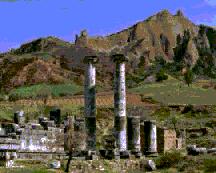Lydian language
Lydian belongs to New Anatolian languages, derived from Old Anatolian -
Hittite, Luwian and
Palaic. When the Hittite Empire fell, Anatolian
city-states started a new epoch of Indo-European settlers of Asia Minor.
These cities were inhabited both by Indo-European Hittites and non-Indo-European
tribes like Hatti, Assyrians, Aramaeans. In the 7th century B.C. all East
and Central Anatolian Indo-Europeans were practically assimilated by Semitic
and other tribes, and Indo-European Hittites and Luwians had to move farther
to the West, to the shores of the Aegean Sea.

Lydia was situated in the Western part of Asia Minor, on the river
Galis, with its main city Sardis. It was first mentioned by Homer already
in the 8th century B.C. under the name Maeonia. It was celebrated for fertile
soil, rich deposits of gold and silver. Lydia became most powerful under
the dynasty of the Mermnadae, beginning about 685 BC. In the 6th century
BC Lydian conquests transformed the kingdom into an empire. Under the rule
of King Croesus, Lydia attained its greatest splendor. The empire came
to an end, however, when the Persian ruler Cyrus the Great captured Sardis
about 546 BC and incorporated Lydia into the Persian Empire. After the
defeat of Persia by Alexander III, king of Macedonia, Lydia was brought
under Greek-Macedonian control. Soon after that, Lydians were assimilated
by Greeks, Greek language and Greek culture, and though Strabo in the 1st
century A.D. talks about Lydians as an ethnos, they did not have much of
their original language at that moment.
Lydian was inherited directly from Hittite,
but has a lot of its own new features. Lydian phonetics is more complicated:
nasal vowels [a], [e] appeared; consonant system has several palatals for
[s], [t], [d], [l], [n] very widely used. Palatals came from the combination
of i + a consonant.
Lydian morphology also differs somehow from Hittite.
Nouns are declined in pronominal declension, Hittite
noun declension was almost completely lost. Accusative case is being replaced
by dative in the meaning of direct object of the verb. Some verbal forms
have endings derived not from Hittite same forms
but from participles (for example, 3rd person plural has -l ending)
or other verbal nouns.
Lydian has a wide choice of prefixes and particles with practically
every word. Sometimes a personal pronoun has 3 particles before it, all
of them meaning just emphasis.
Linguistic science has not yet learned much about Lydian, but the language
is obviously Indo-European, and a lot of words represent their IE origin.
Soon we will publish the Historical Lydian Grammar in our Indo-European
Grammars section for everyone interested in Indo-European languages
on the Web.
